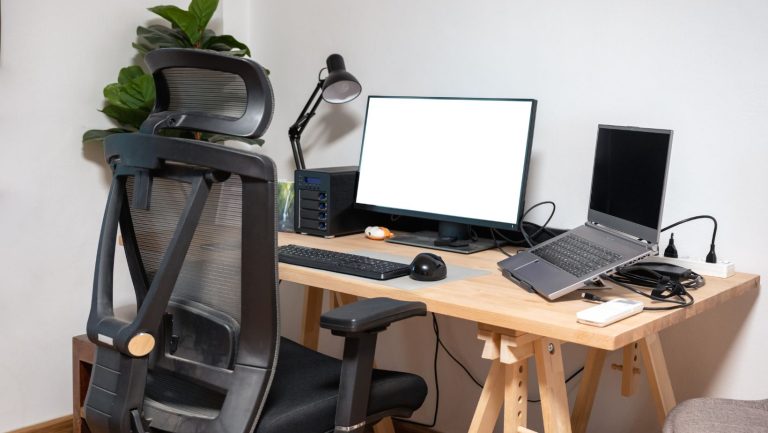The Ultimate Guide to Setting Up an Ergonomic Home Office
Picture this: the year is 2023, and the traditional office set-up has been reshaped by a revolution that’s been steadily brewing – the rise of remote work. With the advent of technology and the unprecedented changes brought about by global events, more people than ever have embraced the work-from-home lifestyle. But trading your corporate cubicle for your cozy home doesn’t come without challenges.
One of the key challenges is setting up a workspace that’s not just comfortable, but also contributes positively to your health and productivity. Enter the concept of an ergonomic home office. This guide will serve as your roadmap to creating a workspace that’s designed to minimize discomfort and maximize efficiency. So, let’s dive in and explore the art of setting up an ergonomic home office.
Understanding Ergonomics and Its Importance
The Science of Comfort: What is Ergonomics?
Ergonomics, in its simplest form, is the study of people’s efficiency in their working environment. It’s a science that looks at how to make your work environment fit you, rather than forcing yourself to fit your work environment. It involves designing your workspace in such a way that it complements the strengths and abilities of your body and reduces strain and discomfort.
Why Ergonomics Matters in Your Home Office?
So, why does ergonomics matter when it comes to your home office setup? The answer lies in the potential health and productivity benefits it offers. An ergonomic workspace can help to reduce the risk of strain and injury that can come from sitting in an uncomfortable position for extended periods. It can help to boost your productivity by making it easier for you to stay comfortable and focused.
Essential Components of an Ergonomic Home Office
Choosing the Right Desk: The Foundation of Your Workspace
Your desk is the foundation of your workspace, and choosing the right one is a critical step in setting up an ergonomic home office. The right desk not only provides a space for your computer and other tools, but it also plays a significant role in maintaining good posture and reducing physical stress.
When selecting a desk, consider the following factors:
- Height: The height of your desk should allow you to sit with your feet flat on the floor and your knees at a 90-degree angle. If you’re tall or short, consider investing in a height-adjustable desk.
- Width and Depth: Ensure your desk is wide and deep enough to accommodate your computer, keyboard, and any other necessary tools with plenty of room to spare. You should be able to comfortably reach everything you need without stretching.
- Adjustability: Adjustable desks allow you to switch between sitting and standing, promoting movement and flexibility throughout your workday.
Selecting an Ergonomic Chair: Your Trusted Companion
Next to your desk, your office chair is arguably the most crucial component of an ergonomic workspace. A good chair can support your body throughout the day, promote good posture, and reduce the risk of back pain and other physical ailments.
When choosing an office chair, look for the following features:
- Adjustability: Look for a chair with adjustable height and backrest. This allows you to tailor the chair to your body’s needs.
- Lumbar support: A good office chair should have excellent lower back support to help maintain the natural curve of your spine.
- Seat depth and width: The seat should be wide and deep enough to support you comfortably. You should be able to sit with your back against the backrest and have about 2-4 inches between the back of your knees and the seat of the chair.
- Material and padding: The chair should be comfortably padded and made of a breathable material.
Remember, a good chair is a worthwhile investment for your ergonomic home office, and it’s something you’ll thank yourself for in the long run.
Positioning Your Computer or Laptop: The Key to Comfortable Viewing
Where you place your computer or laptop can have a significant impact on your comfort and productivity. Ideally, your computer screen should be at eye level or slightly below, about an arm’s length away. This position reduces the risk of neck and eye strain.
If you’re using a laptop, consider investing in a laptop stand or a monitor riser. These tools can help elevate your laptop to a more comfortable viewing height. Pair this with an external keyboard and mouse for an optimal setup.
Keyboard and Mouse Considerations: Your Tools of Trade
An ergonomic keyboard and mouse are essential tools in any ergonomic home office. They can help to minimize strain on your hands, wrists, and shoulders, especially during long periods of typing or navigating on your computer.
When using your keyboard and mouse, keep the following tips in mind:
- Keep them within easy reach: Your keyboard and mouse should be located so that your elbows stay close to your body and your arms form an “L” shape at the elbow joint.
- Choose ergonomic designs: Ergonomic keyboards and mice are designed to promote a more natural hand and wrist position.
- Take regular breaks: Every 30 minutes or so, take a short break. Stretch your fingers, hands, arms, and shoulders to prevent stiffness and discomfort.
Lighting Your Workspace: An Illuminating Factor
Good lighting is a critical, yet often overlooked component of an ergonomic home office. Proper lighting can reduce eye strain and headaches, making it easier for you to focus on your work.
Where possible, take advantage of natural light. Position your desk near a window where you can receive plenty of sunlight. If natural light isn’t sufficient, consider adding a desk lamp with adjustable brightness.
Choose a lamp that’s flexible and can be easily adjusted to eliminate shadows or glare on your workspace.
Organizing Your Workspace: A Place for Everything and Everything in Its Place
A well-organized workspace isn’t just pleasing to the eye; it can also boost productivity and contribute to a more ergonomic environment. A tidy desk means you can easily reach what you need without unnecessary stretching or straining.
Here are some tips and tools to keep your workspace organized:
- Use desk organizers: These can help keep your essential items like pens, notebooks, and other office supplies within easy reach.
- Manage your cables: Use cable clips or ties to keep your computer cables tidy and out of the way.
- Make use of vertical space: If desk space is limited, consider wall-mounted shelves or a pegboard to store items.
- Keep it clean: Regularly clean your desk to keep it free from dust and clutter.
Additional Tips for an Ergonomic Home Office
While the right furniture and organization are crucial, there are other elements to consider when setting up your ergonomic home office.
Regular Breaks and Movement: The Power of Pause
One key factor in maintaining an ergonomic workspace is taking regular breaks. No matter how comfortable your setup is, sitting for prolonged periods can lead to stiffness and discomfort. Aim for a short break every hour or so. Stand up, stretch, or take a short walk. Not only will this help to reduce physical strain, but it can also boost your concentration and productivity.
Desk Exercises and Stretches: Small Movements, Big Impact
Desk exercises and stretches can be a great way to reduce strain and discomfort during your workday. Simple movements like neck rolls, shoulder shrugs, and wrist stretches can help to keep your body flexible and reduce tension.
Consideration of Standing Desks or Adjustable Workstations: Taking a Stand for Health
Standing desks or adjustable workstations can be a great addition to an ergonomic home office. These allow you to alternate between sitting and standing, promoting movement and reducing the risks associated with prolonged sitting.
Tech Tools and Apps: Your Digital Aides
Lastly, don’t forget about the role of technology in promoting better posture and work habits. There are numerous apps and tools available that can remind you to take breaks, guide you through desk exercises, or even help to ensure your screen is at the correct height and distance.
Investing in Your Ergonomic Home Office
Budget Considerations: Investing in Comfort and Productivity
Setting up an ergonomic home office is an investment in your comfort, health, and productivity. While it might require an upfront cost, the long-term benefits make it worthwhile.
Remember, you don’t have to break the bank to create an ergonomic workspace. There are plenty of budget-friendly options available, and even small changes can have a big impact. Start with what you have, and upgrade as your budget allows.
Where to Shop: Finding Your Ergonomic Essentials
There are numerous places to find ergonomic furniture and tools, both online and in physical stores. Look for retailers that specialize in office furniture, as they often offer a wide range of ergonomic options. Don’t forget to read reviews and check the product specifications before making a purchase.
Conclusion: Your Journey to an Ergonomic Workspace
As we wrap up this guide, remember that setting up an ergonomic home office is a journey, not a destination. It’s about making ongoing adjustments and improvements to create a workspace that supports your health and productivity.







